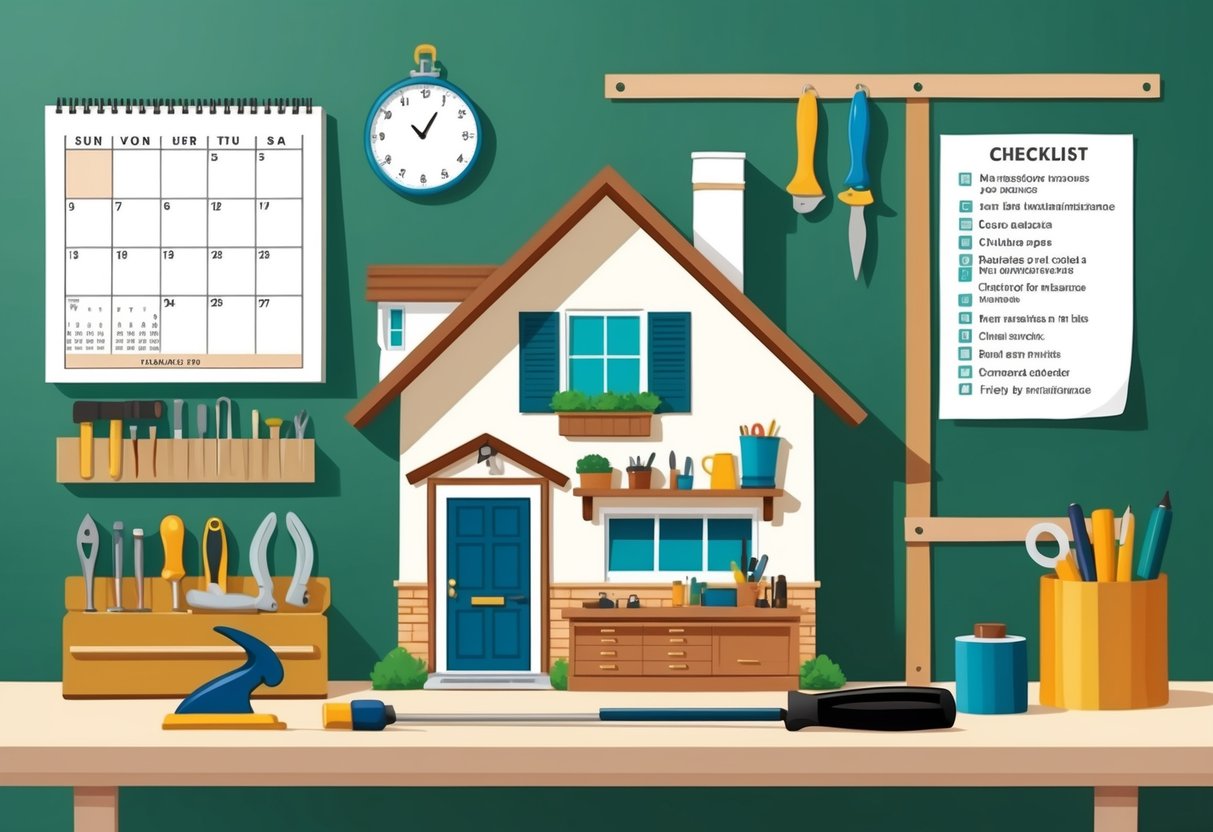
Creating a Customized Home Maintenance Checklist
A personalized home maintenance checklist helps homeowners address tasks that directly impact their property’s condition and value.
Customizing these maintenance tasks ensures efficient upkeep and prevents unexpected costly repairs.
Essential Routine Tasks
Routine maintenance should address both the most common and impactful issues found in residential properties.
Key tasks include checking HVAC filters, cleaning gutters, inspecting roof shingles, and monitoring plumbing for leaks.
Establishing a list of these core actions helps homeowners tackle problems before they worsen.
Additional items to consider are draining the water heater annually, testing smoke and carbon monoxide detectors, and ensuring exterior drainage is clear.
Regular care keeps appliances efficient, prolongs the roof and HVAC system lifespan, and reduces the risk of structural damage.
Using a monthly, seasonal, or annual frequency table helps organize these responsibilities.
For example:
| Task | Frequency |
|---|---|
| Change HVAC filters | Monthly |
| Clean gutters | Spring/Fall |
| Inspect roof | Annually |
| Test smoke/carbon detectors | Monthly |
| Drain water heater | Annually |
Incorporating Regular Inspections
Regular inspections are critical for identifying potential issues before they require expensive repairs.
Homeowners should visually assess their roof, siding, and foundation for cracks, leaks, or damage.
Catching small problems early often reduces repair costs.
It is helpful to inspect attics and basements for signs of moisture, pests, or mold.
Examine windows and doors for proper seals, which reduces energy bills and prevents drafts.
Scheduling a professional HVAC and plumbing inspection once a year also adds a safeguard to the home’s major systems.
Committing to these inspections means items can be repaired or cleaned before the next maintenance cycle.
Doing so ensures long-term protection for all major home components, as described in this home preventative maintenance schedule guide.
Tracking and Scheduling Maintenance
Efficient tracking and scheduling keep maintenance tasks from slipping through the cracks.
Many homeowners rely on digital spreadsheets, calendar reminders, or dedicated apps to stay on top of routine care and home inspections.
Building a calendar with alerts for each monthly, seasonal, and annual job ensures deadlines are not missed.
This strategy also makes it easier to budget for larger, infrequent projects like roof replacements or HVAC servicing.
Some choose to print a home maintenance checklist spreadsheet and place it in a visible spot as a constant reminder.
Regularly updating the checklist after each completed task brings a sense of progress and helps track recurring issues or repairs.
Over time, a clear record of what’s been done streamlines planning and maintains long-term property value.
Daily and Weekly Maintenance Tasks for Cost Savings
Attending to small maintenance tasks every day and week helps prevent expensive repairs later.
By focusing on water leaks, indoor air quality, and general cleanliness, homeowners can address common problem areas and keep their property in good shape.
Inspecting for Leaks and Water Damage
Catching leaks early is critical for preventing costly water damage and mold growth.
Homeowners should check under sinks, around toilets, and near appliances like refrigerators or water heaters for signs of drips or moisture.
Spotting a leaky faucet quickly can keep utility bills in check because even one dripping tap can waste gallons each day.
Inspect ceilings and walls for discoloration or soft spots, as these may indicate hidden leaks.
Look for water stains, warping, or bubbling paint—early warning signs that require prompt attention.
Exterior checks during wet weather can help spot foundation seepage or clogged gutters before they contribute to structural issues or basement flooding.
Addressing small issues fast, such as tightening a connection or replacing a washer, can reduce the risk of having to repair large areas of drywall or flooring.
For a more detailed approach to preventative maintenance, see this home maintenance checklist.
Checking Air Filters and Smoke Detectors
For optimal indoor air quality and fire safety, air filters and smoke detectors require regular attention.
Change or clean air filters in the HVAC system every 1-4 weeks depending on use and household conditions (such as pets or allergies).
Clean filters help systems run efficiently, lowering energy costs and reducing strain on equipment.
Testing smoke detectors weekly ensures these essential devices remain functional.
Homeowners should press the test button and listen for the alarm.
Batteries should be replaced at least every six months or immediately if the detector chirps.
Dust around the detector to keep sensors clear and effective.
Keeping a consistent schedule for these checks can prevent major breakdowns and household dangers.
Many homeowners find setting calendar reminders helpful, as recommended in this annual maintenance plan guide.
Simple Cleaning and Upkeep
Routine cleaning forms the foundation of preventative home maintenance.
Dusting, vacuuming, and wiping down high-touch surfaces not only improve air quality but also make it easier to spot developing issues, such as mold or infestations.
Sweeping debris from floors reduces wear on finishes and helps maintain indoor comfort.
Check entryways, windowsills, and vents for buildup or obstructions that could lead to water intrusion or decreased airflow.
Early removal of dirt and grime prevents long-term stains and damage, lowering the need for professional cleaning or costly cosmetic repairs.
Organizing cleaning supplies, creating a checklist, and delegating tasks can keep family members engaged and accountable.
Following step-by-step routines helps ensure areas aren’t neglected and supports overall cost savings by prolonging the life of home surfaces and systems, which aligns with industry advice such as the AARP Foundation’s maintenance tips.